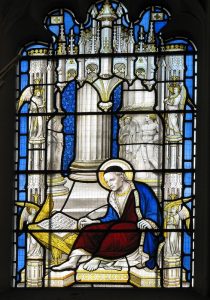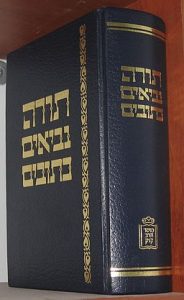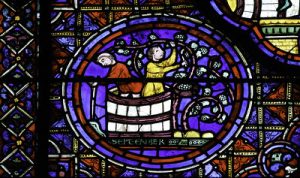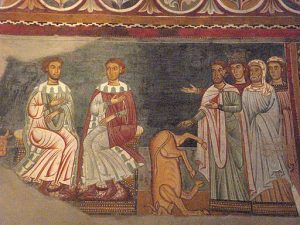Where and how did it all start?

It is important to have some history and context of the Bible in order to even begin reading it. Who wrote it? When? Where? And why?
A wonderful Bible as Literature text is one written by Gabel, Wheeler, York, and Citano called “Bible as Literature: an Introduction” published by Oxford University Press. In their introduction, they say,
“Before going on, we should make clear what this book is not….not a commentary on the Bible book by book…nor an attempt to impose an interpretive scheme [on it]…nor an advocate for the value of the the Bible as a vehicle of moral instruction… It is sufficient for our purpose that the Bible be–as it is–a fascinating human document of enormous importance to the culture and history of the modern world, a document that can speak volumes to humans about their own humanity. It would be inappropriate for us to go beyond this view, for everything beyond it is in the area of personal belief and is subject to sectarian controversy”.
This text is going to treat the Bible as a human construction, as clearly it is that. The spiritual and inspirational aspects of this collection of materials is an added layer of meaning to the human construction. How the Bible is interpreted and used is, often, very much due to the beliefs and tradition of the person using the Bible. The text attempts to tie specific information about the Bible’s content to good scholarly research and archaeological work, as well as careful literary analysis, and to language and translation research.
 When working in the section of the Bible known in Christian (and many public) circles as the Old Testament, the text will call it the Hebrew Scriptures or the Tanakh, as these are terms used by the Jewish people for whom this material was originally written. When referring to the section of the Bible used only by Christians, the text will call it either the Christian Scriptures or the New Testament, as these are terms used by the Christians for whom it was written.
When working in the section of the Bible known in Christian (and many public) circles as the Old Testament, the text will call it the Hebrew Scriptures or the Tanakh, as these are terms used by the Jewish people for whom this material was originally written. When referring to the section of the Bible used only by Christians, the text will call it either the Christian Scriptures or the New Testament, as these are terms used by the Christians for whom it was written.
Quotes from the Bible in this text will be taken from the New Revised Standard Version of the Bible, published by Oxford University Press. This version has been made available by copyright © 1989 Division of Christian Education of the National Council of the Churches of Christ in the USA. As much loved as the King James Version is by many, it is not as accurate an English translation for modern speakers as the NRSV. English as it was used in 1611, the publication date of the KJV, and English as it is spoken now are very different languages!
Exercise: Watch this!
It often helps to get a little historical context for the era in which something is written, whether it is William Shakespeare, Toni Morrison, Agatha Christie, or the Bible. Here is a little tongue in cheek but useful narrative giving some history of the time period of the Bible! (The title talks about Christianity, but the narrative includes early Judaism, too)
While reading the Bible “as literature” what is really meant is that the text is going to approach this book as if it were any other book.
- It will look at this material as written down by humans for humans in languages native to their time and place.
- It will look at the literary forms used by those writers, and what they would have meant at the time to the people who used those forms.
- Even more important, it will look at the Bible as material written from specific perspectives. The various Biblical writers will have had experiences and ideas informed by the activities and ideas of their own specific time and place.
- It is not possible to get directly into the minds of these writers from so long ago, but it can be helpful to have historic, geographic, cultural and religious contexts to help us understand what various writers might have in their personal backgrounds, and what things happened both religiously and historically that the writers might respond to in their work.
So the text asks what each writer was trying to accomplish, how they tried to do that, and how to make sense of their work, understanding the context and intent.
Yes, the book is going to talk about sermons and prophecies, myths and poetry, letters and parables. But it is also going to talk about the reasons that the authors chose those formats, used those formats, and in using them, how they presented their ideas.

Understanding allegory will be useful, but so will understanding a little basic Middle Eastern history! It helps to know about the various formats of parables, but also about things like agriculture, political history and geography of the places where the parables were written and spoken.
It will be important, too, to realize that much of what was written down was written down “eventually”. Very little of the Bible is somehow “history” as modern people think of it. The Bible has never been intended as a “report” on all the details of any events. Instead, each writer takes oral and written traditions that he or she might know about, identifies an audience, makes clear an intended point of view, and then takes something that may have happened (or not…) and writes about it to make a point.
Did the Egyptians regard the Israelites in the same way that the Israelites regarded themselves? Of course not. Did the Egyptians believe the Jews to be the “chosen people” by a god named Yahweh? No. And it works the other way, too! So the Jewish narratives about the Egyptians are, of course, biased. Understandably so!
Two very different creation accounts in the Bible, included by the Biblical editors, were considered as critical to have included for study. Why? The text will talk about that! There are four canonical gospels. Did the Bible need all four in order to tell the story of Jesus? Well, apparently the editors thought so! Why? The text will talk about that, too.
Very little of the content of the Bible was written by a single author. So much editing, collaboration, consolidation and addition has happened that, with a very few exceptions, we cannot call many books in the Bible the work of one hand or one voice. A few books seem to have a primary voice, but even in the case of our four gospels, almost nothing is known about the authors, other than whatever tradition has said about them. What is known about various authors are the words and phrases, literary formats and hints that they offer. What kind of Greek did the author of Luke use? How were Hebrew psalms put together? Is the word usage in early Isaiah the same as word usage in later Isaiah? Why are there so many names for God in the Torah? Why does a little Aramaic get used here and there instead of Hebrew?

And the reader will have to look at places where editing, additions, subtractions, redaction and consolidation has happened within the texts of the Bible. This happened virtually everywhere in the Bible. There are many examples of various versions of some story being included in the Bible, and there are often conflicting details in those different versions of a story. And yet no Biblical editor has ever, finally, “cleaned up” the differing versions, or edited out the contradictions. We still have 2 sets of things happening to Noah, or 2 different groups of people who took Joseph to Egypt, or Job presented as a story and then as a kind of extended poem, or a whole variety of things that Jesus supposedly said on the cross. There has never been anyone who fixed all this to read smoothly and without bumps. So it is vital to take into account the redactors and editors and their input as often as one takes into account the work of the original writers. These editors are very important to the content of the Bible, and those editors likely included bits of their own work to the documents and stories and oral materials that they were working from! And they left all the contradictions found there, all over the Bible, for a reason.
But any reader also wants to remember to set the sections of the Bible into an historical context. This is an anthology, and it has been scrupulously and diligently assembled, connected to other materials in the Bible, and created as something that depends on the reader knowing or being aware of other portions of writing within the Bible. One has to make sure that the context of any one bit of writing is understood for its place in the whole. Jesus in the New Testament speaks directly from the psalms and prophets, showing his Jewish foundations. Prophets refer to the Torah and the covenant. The kings of Israel are revered long past the time of the kingdom of Israel. Can one read Matthew having never read the Hebrew Scriptures? Yes, but with much less understanding of what is actually going on in Matthew’s gospel.
It may seem as though the text is dissecting the Bible in ridiculous ways at times, but hopefully this process will put enough foundation under what a reader encounters in the Bible that any reader can read with far more understanding and knowledge than they had when first reading the material, and with insight as to how the original people, and even people throughout centuries of time, might have used these materials, too.

May, Herbert G., et al. The New Oxford Annotated Bible with the Apocrypha: Revised Standard Version, Containing the Second Edition of the New Testament and an Expanded Edition of the Apocrypha. Edited by Michael D Coogan, Oxford University Press, 2007.
Gabel, John B. The Bible as Literature: An Introduction. Oxford University Press, 2006.
“Christianity from Judaism to Constantine: Crash Course World History.” Crash Course: World History, https://www.youtube.com/watch?v=TG55ErfdaeY.
